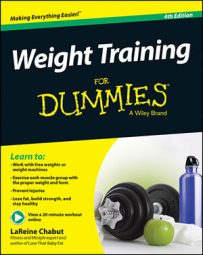Before you begin any weight-training exercises, it helps to get a sense of your fitness level. Here are some key questions you should ask yourself:
When was the last time you did a sit-up? Have you been consistently exercising for the past 6 to 12 months, or can you not remember the last time you worked out? If you do work out currently, how many times a week do you exercise?
If you answered not at all or not consistently in the past 6 months, even if you were an athlete in high school, you’re a beginner. If you’ve been working out three to five times a week for six months, you’re in the intermediate category. And if you’ve been working out consistently, lifting weights three to five times a week, and your progress has slowed or come to a halt, you’re in the advanced category.
How much cardio do you get? Aerobic exercise is really important for good circulation and maintaining a healthy heart. Providing oxygen to your blood and pumping blood through your veins keeps everything running smoothly and helps you sleep better, too!
If you get winded walking up stairs, you’re a beginner. If you can maintain your level of energy during aerobic activities, you’re in the intermediate category. And if you play a team sport on a large field, you’re in the advanced category.
How would you rate your strength? If you’ve never lifted weights or it’s been a while (even if you were an athlete in high school), you’re a beginner. If you’re familiar with weight-training concepts and you currently lift light to moderate weights on a regular bases, you’re in the intermediate category. And if you can lift 100 pounds for eight to ten reps, you’re in the advanced category.
How flexible are you? If you do plenty of strength training and cardio, but you don’t do any stretching, you’re creating an imbalance in your body. To prevent injuries and learn how to maintain balance, regularly do some stretching, yoga, or Pilates. Flexibility plays a big part in overall fitness.
If you’re sedentary and you can’t touch your toes, you’re a beginner. If you stretch major muscle groups two to three times a week, you’re in the intermediate category. And if you can progress through an advanced level of yoga poses or variable stretches, you’re in the advanced category.
Having answered these four questions, you should have a general sense of whether you’re a beginner, advanced, or in between. If you’re in doubt, err on the side of taking it easier in the beginning — you can always work up to a more advanced level, but if you push too hard in the beginning, you may injure yourself.
Here’s what each of these categories means in terms of weight-training exercises:
Beginner: If you’re at the beginner level, start out doing one set of ten repetitions of exercises. You can always add another set of ten reps when you feel you’ve mastered the proper form. Also, plan on weight training twice a week, and do some form of cardio training (for example, walking, biking, or swimming) three times a week.
Listen to your body and don’t move forward until you feel you’re ready.
Intermediate: If you’re at the intermediate level, do one set of 15 repetitions of the various exercises. If you feel confident that you’re using proper form and one set is too easy, you can add another set of 15 reps. Otherwise, complete two weeks of training before adding a second set of 15 reps to each exercise.
Advanced: If you’re at the advanced level, start out with two sets of 20 repetitions. Using a high amount of reps leads to increased muscle endurance rather than strength and size.

